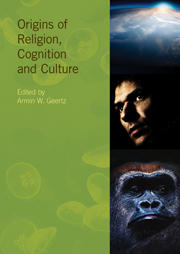Book contents
- Frontmatter
- Contents
- Contributors
- Introduction
- Part I EVOLUTIONARY SCENARIOS
- Part II COGNITIVE THEORIES
- 11 Cognition and meaning
- 12 Wittgenstein and the naturalness of religious belief
- 13 “Peekaboo!” and object permanence: on the play of concealment and appearance in cognition and religion
- 14 Yogācāra Buddhist views on the causal relation between language, cognition and the evolution of worlds
- 15 A resource model of religious cognition: motivation as a primary determinant for the complexity of supernatural agency representations
- 16 The recognition of religion: archaeological diagnosis and implicit theorizing
- 17 Religion and the extra-somatics of conceptual thought
- 18 Tools for thought: the ritual use of ordinary tools
- 19 Care of the soul: empathy in dualistic worldview
- 20 From corpse to concept: a cognitive theory on the ritualized treatment of dead bodies
- 21 Anthropomorphism in god concepts: the role of narrative
- Index
16 - The recognition of religion: archaeological diagnosis and implicit theorizing
from Part II - COGNITIVE THEORIES
- Frontmatter
- Contents
- Contributors
- Introduction
- Part I EVOLUTIONARY SCENARIOS
- Part II COGNITIVE THEORIES
- 11 Cognition and meaning
- 12 Wittgenstein and the naturalness of religious belief
- 13 “Peekaboo!” and object permanence: on the play of concealment and appearance in cognition and religion
- 14 Yogācāra Buddhist views on the causal relation between language, cognition and the evolution of worlds
- 15 A resource model of religious cognition: motivation as a primary determinant for the complexity of supernatural agency representations
- 16 The recognition of religion: archaeological diagnosis and implicit theorizing
- 17 Religion and the extra-somatics of conceptual thought
- 18 Tools for thought: the ritual use of ordinary tools
- 19 Care of the soul: empathy in dualistic worldview
- 20 From corpse to concept: a cognitive theory on the ritualized treatment of dead bodies
- 21 Anthropomorphism in god concepts: the role of narrative
- Index
Summary
Introductory remarks
Students of religion have many good reasons to avoid the domain of prehistory. On the one hand, the very term “prehistoric religion” evokes a host of clichés associated with less successful typologies and evolutionary approaches to religion, all of which seem to imply that Palaeolithic and Neolithic populations shared special kinds or modes of religion that could be characterized as “prehistoric”. Furthermore, prehistoric artefacts fail to produce the kind of verifiable semantic input that students of religion are trained to examine before trying to make any substantial claims about religion. Although the apparent innocence of the term “prehistory” would seem to lie in the stress on methods of access — a period in the past only accessible through mute archaeological data, not through linguistic primary or secondary sources that would allow a cross-checking of the data — it is easy to demonstrate how this lack of access has been transferred from the shortcomings of the academic subject to the object of study. The term “prehistoric” often implies much more than the absence of texts. It suggests cultural illiteracy, a lack of complex modes of mediation and signification, cultural invariance and ecological constraint. Instead of calling attention to the fact that prehistoric societies did not leave behind documents that allow us to enter into cultural subtleties and diversities, some scholars prefer to present them as perfectly legible, as more or less analogous and transparent.
- Type
- Chapter
- Information
- Origins of Religion, Cognition and Culture , pp. 310 - 318Publisher: Acumen PublishingPrint publication year: 2013



